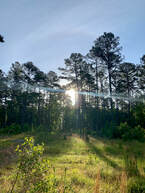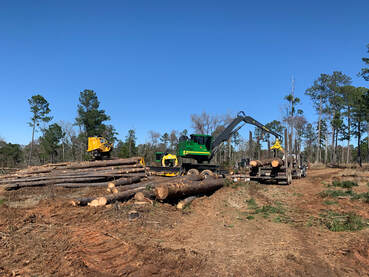Through THE DIRT
Reimagining the Legacy of Black Landownership in Georgia
By Martel Sharpe
Winter 2023
Pictured: Jay Bailey and his wife Blayne ride ATVs on their property.

“I really got tired of the stories that I would hear from my grandparents, uncles, cousins or my parents about how much land we used to own. It was a legacy that was not passed down to me. It’s a legacy that I wanted to reimagine and restart.”
|
In the past three-and-a-half years, Bailey acquired property in Putnam, Wilkinson and Jefferson counties, totaling 3,500 acres. He’s acquired 1,100 acres in Putnam County, where he plans to build an 840-acre private estate and the Black Land Institute (BLI). In Wilkinson County, he holds 1,800 acres that he plans to have for recreation and timber rotation. The 400 acres in Jefferson County are for timber.
Though Bailey is originally from Atlanta, his family origins lie in Putnam County, where he plans to name his private estate Sagewood — in honor of his daughter Sage — and to reestablish his family’s history as landowners in the county. “My family is five generations from Putnam County,” Bailey said. “Farming and agriculture have been in my family since we arrived in Georgia. I would hear stories about my father’s grandfather who owned a large farm and had acres as far as the eye could see. My great uncle in Putnam County purchased 100-plus acres and built his family home there and raised his children on his farm.” A Legacy Reimagined Though Bailey’s family owns property in Putnam County to this day, outside of recent acquisitions, it’s nowhere near the scale that it was 100 years ago. He continued, “I really got tired of the stories that I would hear from my grandparents, uncles, cousins or my parents about how much land we used to own. It was a legacy that was not passed down to me. It’s a legacy that I wanted to reimagine and restart.” Bailey would unknowingly begin his journey into Black landownership, and eventually the timber industry, 20 years ago, when he decided to purchase land for his father. “When my father retired and moved back to Putnam County, we bought about 36 acres where he could start a small cattle farm. It was completely wooded, so my first introduction to timber harvesting was when we cleared out pasture land. We were paid for the timber that was cut off that land,” he said. Fast forward to three-and-a-half years ago, Bailey and his wife bought 185 acres in Putnam County for themselves as their first parcel of land. Through their previous experience with his father’s property, the couple realized that they needed to cut 65-70 acres of timber. This brought Bailey up close and personal with Georgia’s timber industry and piqued his interest in learning more. “When we started to think about sustainability and how we could generate recurring revenues, timber became something that I dug into. We needed to clear some timber anyway for some pasture property and that was my first experience with clearing timber personally,” Bailey said. |
“I stand on the principle of all wealth comes from the dirt. Anything that we own, consume or possess, at one point its elements came from the Earth. And in America, unfortunately, Black people own less than 2% of the dirt.”

|
Georgia Forestry Magazine is published by HL Strategy, an integrated marketing and communications firm focused on our nation's biggest challenges and opportunities. Learn more at hlstrategy.com
|
